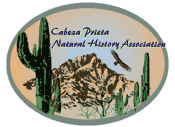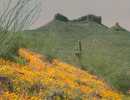
Cabeza Prieta Natural History Association
Members' Stories

Cactus Bees (Diadasia rinconis)
by Bill Perry
Before we had science to tell us what's really happening in this world, humans frequently created myths out of natural occurrences they didn't understand. Phenomena like comets, thunder and lightning and even coyote choruses were often assigned fictional meaning by the ancients who couldn't comprehend their reality. Even today, we occasionally see things that defy explanation. My wife and I once saw a very brief event, potentially frightening and yet wonderful at the same time, that could have been seen by some as a mystical experience.
We were relaxing late one afternoon, reclining in camp chairs, drinks in hand, near White Tanks, a waterhole in the middle of southern Arizona's great Sonoran Desert. It was quiet and serene and nothing was moving in those waning moments of the day. The solitude was lovely. But then, after sitting there a while, it very slowly began to occur to us that something was happening. We weren't alone! Where there had been nothing unusual in our vision before, we now suddenly realized that there were bees - a very few at first, but increasingly more - gyrating all around us in erratic loops within a few feet of the ground. At first there were just a couple of dozen, but then, over the next fifteen minutes, their numbers swelled to hundreds and then thousands. We were enveloped in their swirling energy and there could be no thought of anything else as they formed a cloud that buzzed and pirouetted around our heads in the fading sunlight. Many folks might have felt threatened, but because they showed absolutely no interest in us, we were able to relax and experience something unlike anything we had ever seen before. We were enchanted.
That turbulent cloud continued around us for several minutes and then, as rapidly as they had increased, the bees now began to decrease in numbers. A half hour after it had started, it was all over. We were by ourselves again and full of questions about what had happened. We knew it wasn't a spiritual omen, but what had we seen?
According to The Natural History of the Sonoran Desert, the cactus bee (Diadasia rinconis) is among the most numerous of the perhaps 1,000 species of bees in the Sonoran Desert. As their name suggests, they are important pollinators of cactus--saguaros, chollas, prickly pear and more. Unlike our familiar honey bee, which nests in colonial hives, each female cactus bee creates her own hole in the ground and lines it with waxy secretions, thus making an individual cell for her offspring. Note: the species name rinconis, is similar to the Spanish "rincon," a "corner" or "nook." These cactus bee nooks are often clustered together in de facto colonies called "aggregations." Natural History says "aggregations during the spring cactus bloom may number in the hundreds of thousands of individual nests over an area the size of 2 or 3 tennis courts." That begins to explain what we had witnessed.
One of the reasons we chose that spot near our camp to watch the sunset was that it was flat and without cactus or other plants. Small gravel uniformly covered the surface. Given that there was a water source nearby and we were surrounded by millions of acres of prime cactus habitat, it was also a perfect place for cactus bees to aggregate. What we had seen was probably a daily event at this insect city, the hard-working female bees returning from a day of pollinating, laden with the flower dust used to feed their larvae. The mystery is how each bee found her own nesting hole. Is that what the minutes of circling around were all about? In any case, we felt very lucky to have experienced something that we had never heard of. Also, we now understand that the unique cacti species that surround us live in symbiosis with the bees and that neither would survive without the other.
Copyright Creative Commons
HTML & Programing by
Thomas R. Powell